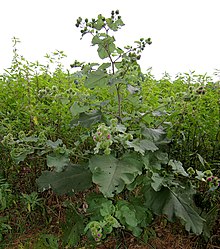Arctium lappa
| Burdock | |
|---|---|
 |
|
| Greater Burdock | |
| Scientific classification | |
| Kingdom: | Plantae |
| (unranked): | Angiosperms |
| (unranked): | Eudicots |
| (unranked): | Asterids |
| Order: | Asterales |
| Family: | Asteraceae |
| Genus: | Arctium |
| Species: | A. lappa |
| Binomial name | |
|
Arctium lappa L. |
|
| Synonyms | |
|
Synonymy
|
|
| Nutritional value per 100 g (3.5 oz) | |
|---|---|
| Energy | 302 kJ (72 kcal) |
|
17.34 g
|
|
| Sugars | 2.9 |
| Dietary fiber | 3.3 g |
|
0.15 g
|
|
|
1.53 g
|
|
| Vitamins | |
| Thiamine (B1) |
(1%)
0.01 mg |
| Riboflavin (B2) |
(3%)
0.03 mg |
| Niacin (B3) |
(2%)
0.3 mg |
| Pantothenic acid (B5) |
(6%)
0.321 mg |
| Vitamin B6 |
(18%)
0.24 mg |
| Folate (B9) |
(6%)
23 μg |
| Vitamin C |
(4%)
3 mg |
| Vitamin E |
(3%)
0.38 mg |
| Vitamin K |
(2%)
1.6 μg |
| Minerals | |
| Calcium |
(4%)
41 mg |
| Iron |
(6%)
0.8 mg |
| Magnesium |
(11%)
38 mg |
| Manganese |
(11%)
0.232 mg |
| Phosphorus |
(7%)
51 mg |
| Potassium |
(7%)
308 mg |
| Sodium |
(0%)
5 mg |
| Zinc |
(3%)
0.33 mg |
|
|
|
|
|
| Percentages are roughly approximated using US recommendations for adults. Source: USDA Nutrient Database |
|
Arctium lappa, commonly called greater burdock,gobō, edible burdock,lappa,beggar's buttons,thorny burr, or happy major is a Eurasian species of plants in the sunflower family, cultivated in gardens for its root used as a vegetable. It has become an invasive weed of high-nitrogen soils in North America, Australia, and other regions.
Greater Burdock is a biennial plant, rather tall, reaching as much as 3 m (10 ft). It has large, alternating, cordiform leaves that have a long petiole and are pubescent on the underside.
The flowers are purple and grouped in globular capitula, united in clusters. They appear in mid-summer, from July to September. The capitula are surrounded by an involucre made out of many bracts, each curving to form a hook, allowing them to be carried long distances on the fur of animals. The fruits are achenes; they are long, compressed, with short pappuses. The fleshy tap-root can grow up to 1 m (3 ft 3 in) deep.
This species is native to the temperate regions of the old world, from Scandinavia to the Mediterranean, and from the British Isles through Russia, and the Middle East to India, China, Taiwan and Japan.
It is naturalized almost everywhere and is usually found in disturbed areas, especially in soil rich in nitrogen. It is commonly cultivated in Japan where it gives its name to a particular construction technique, burdock piling.
...
Wikipedia
